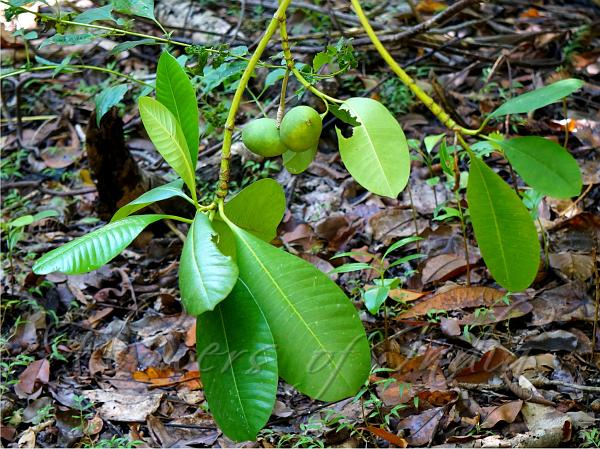|
| Twin Apple |
|

|

| File size | 865265 |
| Original date | 1/7/17 12:29 PM |
| Resolution | 2048 x 1536 |
| Flash | Flash did not fire, auto |
| Focal length | 55.0mm |
| Exposure time | 1/160s |
| Aperture | 4.5 |
| Focus Distance | |
| Metering Mode | Multi-segment |
| Camera make | SONY |
| Camera model | ILCE-3500 |
| Sensor type |
|
|
|
|
Photo: |
Botanical name: Ochrosia oppositifolia Family: Apocynaceae (Oleander family)
Synonyms: Ochrosia parviflora, Ochrosia cowleyi, Cerbera oppositifolia
Synonyms: Ochrosia parviflora, Ochrosia cowleyi, Cerbera oppositifolia
Twin Apple grows as a small to medium-sized tree up
to 25 m tall, with a trunk diameter of up to 50 cm. Its flowers are
small, creamy to white, 5-petaled, 1.3 cm wide, fragrant. Flowers are
borne in 2-17 cm long congested cymes, at branch-ends and in
leaf-axils, in whorls of 2-4. There are more than 30 in each
inflorescence. Sepals are ovate, tip rounded, thick except along the
margin. Stamens are inserted at 2-2.5 mm below the mouth, 0.5-0.7 of
the length of the flower tube. Leaves are in whorls of 3 or 4 (or 5),
leathery or papery when dried. They are obovate in shape, light green,
4.5-36 x 1.5-18 cm. Fruits are composed of twin-fruits. Seeds is often
1 at either placenta, rarely with a small second one. Twin Apple is
native to countries from the Seychelles to Sri Lanka, Andaman and
Nicobar Islands, Thailand, Vietnam, Malaysia, Indonesia, Philippines,
New Guinea to the western Pacific.
Medicinal uses: A leaf decoction is used to
wash the abdomen of women after childbirth. The seeds are used in the
treatment of bilious disorders, in particular as an antidote to the
effect of eating poisonous fish or crabs. A decoction of bark is taken
to purify the blood, as an appetizer, purgative and carminative, and in
high doses as an abortifacient. The wood is febrifugal and stomachic.
Cups made from the wood will give a bitter taste to drinks when allowed
to stand for some time. The drinks are then taken as a stomachic. The
root is used in the treatment of bilious disorders, in particular as an
antidote to the effect of eating poisonous fish or crabs.
A leaf decoction is used to
wash the abdomen of women after childbirth. The seeds are used in the
treatment of bilious disorders, in particular as an antidote to the
effect of eating poisonous fish or crabs. A decoction of bark is taken
to purify the blood, as an appetizer, purgative and carminative, and in
high doses as an abortifacient. The wood is febrifugal and stomachic.
Cups made from the wood will give a bitter taste to drinks when allowed
to stand for some time. The drinks are then taken as a stomachic. The
root is used in the treatment of bilious disorders, in particular as an
antidote to the effect of eating poisonous fish or crabs.
Medicinal uses:
 A leaf decoction is used to
wash the abdomen of women after childbirth. The seeds are used in the
treatment of bilious disorders, in particular as an antidote to the
effect of eating poisonous fish or crabs. A decoction of bark is taken
to purify the blood, as an appetizer, purgative and carminative, and in
high doses as an abortifacient. The wood is febrifugal and stomachic.
Cups made from the wood will give a bitter taste to drinks when allowed
to stand for some time. The drinks are then taken as a stomachic. The
root is used in the treatment of bilious disorders, in particular as an
antidote to the effect of eating poisonous fish or crabs.
A leaf decoction is used to
wash the abdomen of women after childbirth. The seeds are used in the
treatment of bilious disorders, in particular as an antidote to the
effect of eating poisonous fish or crabs. A decoction of bark is taken
to purify the blood, as an appetizer, purgative and carminative, and in
high doses as an abortifacient. The wood is febrifugal and stomachic.
Cups made from the wood will give a bitter taste to drinks when allowed
to stand for some time. The drinks are then taken as a stomachic. The
root is used in the treatment of bilious disorders, in particular as an
antidote to the effect of eating poisonous fish or crabs. | Identification credit: Dhananjay Rawool | Photographed in Little Andaman, Andaman & Nicobar. |
• Is this flower misidentified? If yes,